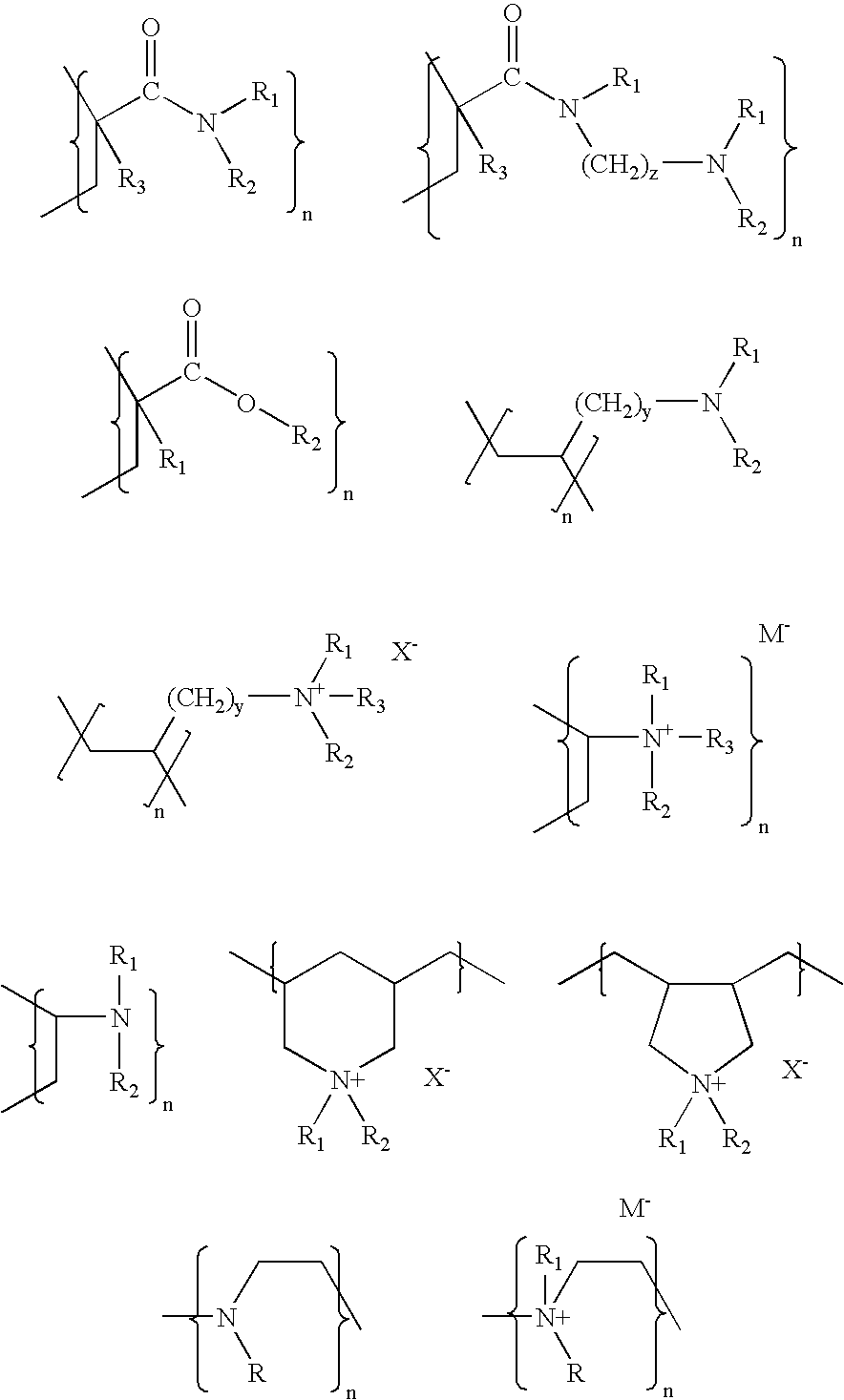Method for treating gout and binding uric acid
a uric acid and gout technology, applied in the field of gout and uric acid binding, can solve the problems that colchicine, the most effective of which is administered orally, cannot be tolerated by 80 percent of people, and achieve the effect of reducing uric acid levels in patients and effective treatmen
- Summary
- Abstract
- Description
- Claims
- Application Information
AI Technical Summary
Benefits of technology
Problems solved by technology
Method used
Image
Examples
example 1
Poly(vinylamine)
[0040]The first step involved the preparation of ethylidenebisacetamide. Acetamide (118 g), acetaldehyde (44.06 g), copper acetate (0.2 g), and water (300 mL) were placed in a 1 L three neck flask fitted with condenser, thermometer, and mechanically stirred. Concentrated HCl (34 mL) was added and the mixture was heated to 45-50° C. with stirring for 24 hours. The water was then removed in vacuo to leave a thick sludge which formed crystals on cooling to 5° C. Acetone (200 mL) was added and stirred for a few minutes, after which the solid was filtered off and discarded. The acetone was cooled to 0° C. and solid was filtered off. The solid was rinsed in 500 mL acetone and air dried 18 hours to yield 31.5 g of ethylidenebis-acetamide.
[0041]The next step involved the preparation of vinylacetamide from ethylidenebisacetamide. Ethylidenebisacetamide (31.05 g), calcium carbonate (2 g) and filter agent, Celite® 541 (2 g) (available from Aldrich, Milwaukee, Wis.) were placed ...
example 2
Poly(allylamine) Hydrochloride
[0044]To a 2 liter, water-jacketed reaction kettle equipped with (1) a condenser topped with a nitrogen gas inlet, (2) a thermometer, and (3) a mechanical stirrer was added concentrated hydrochloric acid (360 mL). The acid was cooled to 5° C. using circulating water in the jacket of the reaction kettle (water temperature=0° C.). Allylamine (328.5 mL, 250 g) was added dropwise with stirring while maintaining the reaction temperature at 5-10° C. After addition was complete, the mixture was removed, placed in a 3 liter one-neck flask, and 206 g of liquid was removed by rotary vacuum evaporation at 60° C. Water (20 mL) was then added and the liquid was returned to the reaction kettle. Azobis(amidinopropane) dihydrochloride (0.5 g) was suspended in 11 mL of water was then added. The resulting reaction mixture was heated to 50° C. under a nitrogen atmosphere with stirring for 24 hours. Additional azobis(amidinopropane) dihydrochloride (5 mL) suspended in 11 m...
example 3
Poly(Allylamine) Hydrochloride Cross-Linked with Epichlorohydrin
[0046]To a 5 gallon vessel was added poly(allylamine) hydrochloride prepared as described in Example 2 (1 kg) and water (4 L). The mixture was stirred to dissolve the hydrochloride and the pH was adjusted by adding solid NaOH (284 g). The resulting solution was cooled to room temperature, after which epichlorohydrin cross-linking agent (50 mL) was added all at once with stirring. The resulting mixture was stirred gently until it gelled (about 35 minutes). The cross-linking reaction was allowed to proceed for an additional 18 hours at room temperature, after which the polymer gel was removed and placed in portions in a blender with a total of 10 L of water. Each portion was blended gently for about 3 minutes to form coarse particles which were then stirred for 1 hour and collected by filtration. The solid was rinsed three times by suspending it in water (10 L, 15 L, 20 L), stirring each suspension for 1 hour, and collect...
PUM
| Property | Measurement | Unit |
|---|---|---|
| Percent by mass | aaaaa | aaaaa |
| Percent by mass | aaaaa | aaaaa |
| Weight | aaaaa | aaaaa |
Abstract
Description
Claims
Application Information
 Login to View More
Login to View More - R&D
- Intellectual Property
- Life Sciences
- Materials
- Tech Scout
- Unparalleled Data Quality
- Higher Quality Content
- 60% Fewer Hallucinations
Browse by: Latest US Patents, China's latest patents, Technical Efficacy Thesaurus, Application Domain, Technology Topic, Popular Technical Reports.
© 2025 PatSnap. All rights reserved.Legal|Privacy policy|Modern Slavery Act Transparency Statement|Sitemap|About US| Contact US: help@patsnap.com



